手册
- Unity User Manual (2020.1)
- 包
- 已验证包
- 2D Animation
- 2D Pixel Perfect
- 2D PSD Importer
- 2D SpriteShape
- Adaptive Performance
- Adaptive Performance Samsung Android
- Addressables
- Advertisement
- Alembic
- Analytics Library
- Android Logcat
- AR Foundation
- ARCore XR Plugin
- ARKit Face Tracking
- ARKit XR Plugin
- Burst
- Cinemachine
- Editor Coroutines
- High Definition RP
- In App Purchasing
- Input System
- JetBrains Rider 编辑器
- Magic Leap XR Plugin
- ML Agents
- Mobile Notifications
- Multiplayer HLAPI
- Oculus XR Plugin
- Polybrush
- Post Processing
- ProBuilder
- Profile Analyzer
- Quick Search
- Remote Config
- Scriptable Build Pipeline
- Shader Graph
- Test Framework
- TextMeshPro
- 时间轴
- Unity Collaborate
- Unity Distribution Portal
- Unity Recorder
- Universal RP
- Visual Effect Graph
- Visual Studio Code 编辑器
- Visual Studio 编辑器
- Windows XR Plugin
- Xiaomi SDK
- XR Plugin Management
- 预览包
- 核心包
- 内置包
- AI
- Android JNI
- 动画
- Asset Bundle
- Audio
- 布料
- Director
- Image Conversion
- IMGUI
- JSONSerialize
- Particle System
- 物理 (Physics)
- Physics 2D
- Screen Capture
- Terrain
- Terrain Physics
- Tilemap
- UI
- UIElements
- Umbra
- Unity Analytics
- Unity Web Request
- Unity Web Request Asset Bundle
- Unity Web Request Audio
- Unity Web Request Texture
- Unity Web Request WWW
- Vehicles
- Video
- VR
- Wind
- XR
- 按关键字排列的包
- Unity 的 Package Manager
- 创建自定义包
- 已验证包
- 在 Unity 中操作
- 安装 Unity
- 升级 Unity
- Unity 的界面
- 资源工作流程
- 创建游戏玩法
- 编辑器功能
- 分析
- 导入
- 输入
- 2D
- 图形
- 渲染管线
- 摄像机
- 后期处理
- 光照
- 网格、材质、着色器和纹理
- 网格组件
- 材质
- 纹理
- 编写着色器
- 标准着色器
- 标准粒子着色器
- Autodesk Interactive 着色器
- 旧版着色器
- 内置着色器的用途和性能
- 普通着色器系列
- 透明着色器系列
- 透明镂空着色器系列
- 自发光着色器系列
- 反光着色器系列
- 反射顶点光照 (Reflective Vertex-Lit)
- 反光漫射 (Reflective Diffuse)
- 反光镜面反射 (Reflective Specular)
- 反光凹凸漫射 (Reflective Bumped Diffuse)
- 反光凹凸镜面反射 (Reflective Bumped Specular)
- 反光视差漫射 (Reflective Parallax Diffuse)
- 反光视差镜面反射 (Reflective Parallax Specular)
- 反光法线贴图无光照 (Reflective Normal Mapped Unlit)
- 反光法线贴图顶点光照 (Reflective Normal mapped Vertex-lit)
- 着色器参考
- 粒子系统
- 选择粒子系统解决方案
- 内置粒子系统
- 使用内置粒子系统
- 粒子系统顶点流和标准着色器支持
- 粒子系统 GPU 实例化
- 粒子系统 C# 作业系统集成
- 组件和模块
- 粒子系统 (Particle System)
- 粒子系统模块
- 粒子系统 (Particle System) 主模块
- Emission 模块
- Shape 模块
- Velocity over Lifetime 模块
- Noise 模块
- Limit Velocity Over Lifetime 模块
- Inherit Velocity 模块
- Lifetime by Emitter Speed
- Force Over Lifetime 模块
- Color Over Lifetime 模块
- Color By Speed 模块
- Size over Lifetime 模块
- Size by Speed 模块
- Rotation Over Lifetime 模块
- Rotation By Speed 模块
- External Forces 模块
- Collision 模块
- Triggers 模块
- Sub Emitters 模块
- Texture Sheet Animation 模块
- Lights 模块
- Trails 模块
- Custom Data 模块
- Renderer 模块
- 粒子系统力场 (Particle System Force Field)
- 内置粒子系统示例
- Visual Effect Graph
- 创建环境
- 天空
- 视觉效果组件
- 高级渲染功能
- 优化图形性能
- 颜色空间
- 图形教程
- 如何修复导入模型的旋转问题?
- 艺术资源最佳实践指南
- 从 3D 建模软件导入模型
- 在 Unity 中制作可信的视觉效果
- Update: believable visuals in URP and HDRP
- Believable visuals: preparing assets
- Believable visuals: render settings
- Believable visuals: lighting strategy
- Believable visuals: models
- Believable visuals: materials and shaders
- Believable visuals: outdoor lighting
- Believable visuals: indoor and local lighting
- Believable visuals: post-processing
- Believable visuals: dynamic lighting
- 在 Unity 中设置渲染管线和光照
- 物理系统
- 脚本
- 多玩家和联网
- 音频
- 视频概述
- 动画
- 创建用户界面 (UI)
- 导航和寻路
- Unity 服务
- Setting up your project for Unity services
- Unity Organizations
- Unity Ads
- Unity Analytics
- Unity Cloud Build
- Automated Build Generation
- 支持的平台
- 支持的 Unity 版本
- 共享链接
- 版本控制系统
- 使用 Unity 开发者控制面板 (Developer Dashboard) 对 Unity Cloud Build 进行 Git 配置
- 使用 Unity 开发者控制面板 (Developer Dashboard) 对 Unity Cloud Build 进行 Mercurial 配置
- 将 Apache Subversion (SVN) 用于 Unity Cloud Build
- 使用 Unity 开发者控制面板 (Developer Dashboard) 对 Unity Cloud Build 进行 Perforce 配置
- 使用 Unity 开发者控制面板 (Developer Dashboard) 对 Unity Cloud Build 进行 Plastic 配置
- 发布到 iOS
- 高级选项
- 在 Unity Cloud Build 中使用可寻址资源
- 编译清单
- 计划构建
- Cloud Build REST API
- Unity Cloud Content Delivery
- Unity IAP
- 设置 Unity IAP
- 跨平台指南
- 应用商店指南
- 实现应用商店
- Unity Collaborate
- Setting up Unity Collaborate
- Adding team members to your Unity project
- 查看历史记录
- Enabling Cloud Build with Collaborate
- 管理 Unity Editor 版本
- Reverting files
- Resolving file conflicts
- 排除资源使其不发布到 Collaborate
- 将单个文件发布到 Collaborate
- 还原项目至以前的版本
- 进行中 (In-Progress) 编辑通知
- 管理云存储
- 将项目移动到另一个版本控制系统
- Unity Accelerator
- Collaborate troubleshooting tips
- Unity Cloud Diagnostics
- Unity Integrations
- Multiplayer 服务
- Unity 分发平台
- XR
- 开源代码仓库
- Asset Store 发布
- 平台开发
- 将“Unity 用作库”用于其他应用程序
- 启用深层链接
- 独立平台
- macOS
- Apple TV
- WebGL
- iOS
- Android
- Windows
- 将 Unity 集成到 Windows 和 UWP 应用程序中
- Windows 通用
- 通用 Windows 平台
- 已知问题
- 移动平台开发者检查清单
- 实验性
- 旧版主题
- Unity 2020.1 中的新功能
- 术语表
- Unity User Manual (2020.1)
- 平台开发
- iOS
- iOS 高级主题
- 应用程序精简
应用程序精简
Apple 商店和 iOS 可根据用户具体设备的性能来定制 iOS、tvOS 和 watchOS 应用程序的分发,从而优化这些应用程序的安装。此优化称为应用程序精简。借助应用程序精简,可以使创建的应用程序利用最多的设备功能、占用最少的磁盘空间并适应 Apple 未来可能应用的更新。请参阅 Apple 关于应用程序精简的开发者库页面,了解有关此优化过程的更多信息。
本章介绍可以在 Unity 中实现的应用程序精简的两个主要组件:
按需加载资源
按需加载资源 (ODR) 是适用于 iOS 和 tvOS 平台(从 iOS 和 tvOS 9.0 版开始)的功能。此功能允许将核心资源(应用程序启动时需要的资源)与可选资源(或者出现在游戏后期关卡中的资源)分开,从而减小应用程序的大小。这些附加资源称为 AssetBundles。它们可用于所有 Unity 构建目标,但必须采取额外步骤才能通过 App Store 托管它们。
AssetBundles 可以包含资源文件,例如模型、材质、纹理和场景,但不能包含脚本。这意味着所有脚本逻辑都必须位于主应用程序中。为减少加载时间(特别是在无线条件下)并最大限度减少设备上使用的存储空间,Apple 建议 AssetBundle 的大小不要超过 64MB。
设置 ODR
要对项目进行 ODR 设置,请首先确认构建类型设置为 iOS。在菜单栏中,选择 File > Build Settings。
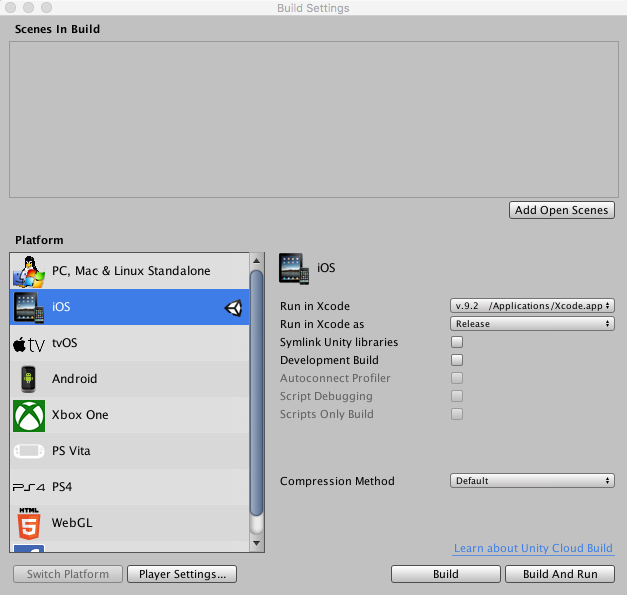
如果尚未选中相关选项,请单击 iOS__,然后单击 Switch Platform__ 按钮。接下来,单击 Player Settings 按钮。在 Inspector 窗口中,打开 Other Settings__,导航到 Configuration__ 部分,然后启用 Use on demand resources 复选框。

创建 AssetBundle
首先,创建一个新文件夹以放置需要添加到 AssetBundle 的资源。要执行此操作,请在 Project 窗口内右键单击,然后选择 Create > Folder__(或单击 Project 窗口左上角的 Create__ > __Folder__)。
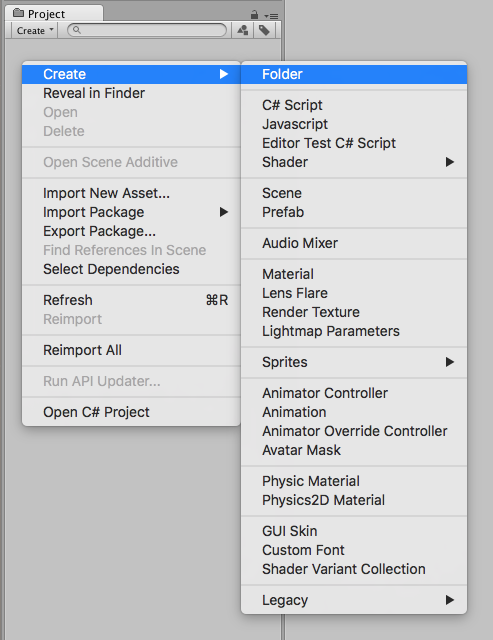
选择要添加到 AssetBundle 的资源文件,然后将它们拖放到新文件夹中。
创建 AssetBundle 时,需要为其分配一个标签,该标签将在请求下载 AssetBundle 时用作标识符。最好创建一个与捆绑包的文件名匹配的标签;这样可以确保标签的唯一性,并便于以后使用时进行识别。
要创建或分配标签,请选择新文件夹,然后导航到 Inspector 窗口底部的 Asset Labels 部分。单击左侧下拉菜单,选择 __New__,然后输入新标签的名称。请注意,AssetBundle 标签必须为小写字母。
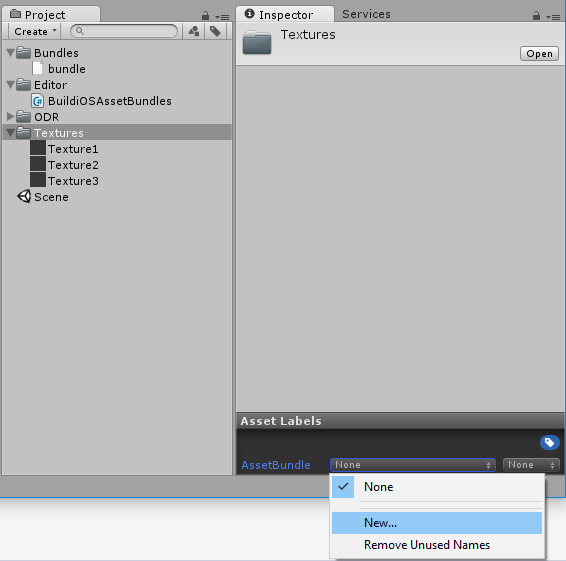
在此示例中,一个名为 Textures 的文件夹被赋予了新标签
要生成新的 AssetBundle 文件,必须在 Editor 脚本中引用新标签。要创建 Editor 脚本,请在 Project 窗口中创建一个名为 Editor 的新文件夹。右键单击 Editor 文件夹,然后选择 Create > C# Script。将新脚本命名为 BuildiOSAssetBundles.cs。
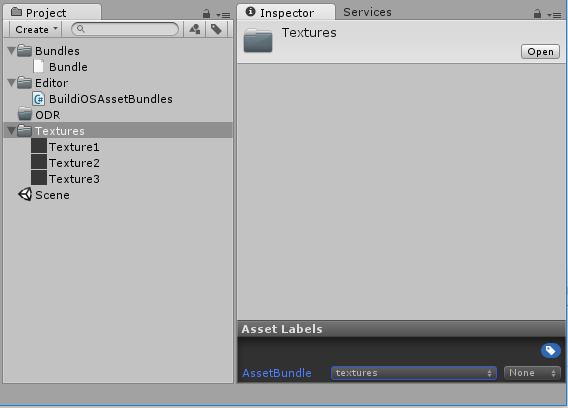
在此示例中,为 Textures 文件夹赋予了标签 textures。在 Editor 文件夹中创建了新脚本 BuildiOSAssetBundles.cs。
打开 BuildiOSAssetBundles.cs 并将以下代码复制到其中。此示例中使用了标签 _textures_;请用所需的标签名称(小写文本)通改此名称。
请注意,此示例使用未压缩的捆绑包;但这并非应用程序精简的要求。
using UnityEngine;
using UnityEditor;
public class BuildiOSAssetBundles : MonoBehaviour
{
[InitializeOnLoadMethod]
static void SetupResourcesBuild( )
{
UnityEditor.iOS.BuildPipeline.collectResources += CollectResources;
}
static UnityEditor.iOS.Resource[] CollectResources( )
{
return new UnityEditor.iOS.Resource[]
{
new UnityEditor.iOS.Resource( "textures", "Assets/ODR/textures" ).AddOnDemandResourceTags( "textures" ),
new UnityEditor.iOS.Resource( "bundle", "Assets/Bundles/bundle.unity3d" ).AddOnDemandResourceTags( "bundle" ),
};
}
[MenuItem( "Bundle/Build iOS AssetBundle" )]
static void BuildAssetBundles( )
{
var options = BuildAssetBundleOptions.None;
bool shouldCheckODR = EditorUserBuildSettings.activeBuildTarget == BuildTarget.iOS;
# if UNITY_TVOS
shouldCheckODR |= EditorUserBuildSettings.activeBuildTarget == BuildTarget.tvOS;
# endif
if( shouldCheckODR )
{
# if ENABLE_IOS_ON_DEMAND_RESOURCES
if( PlayerSettings.iOS.useOnDemandResources )
options |= BuildAssetBundleOptions.UncompressedAssetBundle;
# endif
# if ENABLE_IOS_APP_SLICING
options |= BuildAssetBundleOptions.UncompressedAssetBundle;
# endif
}
BuildPipeline.BuildAssetBundles( "Assets/ODR", options, EditorUserBuildSettings.activeBuildTarget );
}
}
上面代码示例中的重要代码行如下,其中使用带有 textures 标签的文件,并在 Assets/ODR 文件夹中创建名为 textures 的 AssetBundle 文件:
new UnityEditor.iOS.Resource( "textures", "Assets/ODR/textures" ).AddOnDemandResourceTags( "textures" )
出于演示目的,上面的代码示例还包括以下代码行,用于添加一个已经构建的名为 bundle 的 AssetBundle(例如,来自其他项目或第三方供应商):
new UnityEditor.iOS.Resource( "bundle", "Assets/Bundles/bundle.unity3d" ).AddOnDemandResourceTags( "bundle" )
整个代码示例将在 Unity Editor 菜单栏中创建一个新菜单。选择 Bundle > Build iOS AssetBundle。此时将在 ODR 文件夹中生成 AssetBundles。

以下脚本下载 textures ODR Asset Bundle,并将其分配给公共成员 TextureBundle。将此包放在项目的某个位置。
using UnityEngine;
using UnityEngine.iOS;
using System;
using System.Collections;
public class LoadBundle : MonoBehaviour
{
public AssetBundle TextureBundle;
void Start( )
{
StartCoroutine( LoadAsset( "textures", "textures" ) );
}
public IEnumerator LoadAsset( string resourceName, string odrTag )
{
// 创建请求
OnDemandResourcesRequest request = OnDemandResources.PreloadAsync( new string[] { odrTag } );
// 等待请求完成
yield return request;
// 检查是否有错误
if( request.error != null )
throw new Exception( "ODR request failed: " + request.error );
TextureBundle = AssetBundle.LoadFromFile( "res://" + resourceName );
request.Dispose( );
}
}
下一步是生成 Xcode 项目,构建 .IPA,并将其上传到 iTunes Connect 的 TestFlight。在 TestFlight 处理过程中,嵌入式 ODR AssetBundles 将从应用程序中删除并托管在 Apple 的服务器上,可供下载。
在 Xcode 中构建 .IPA 之前,请检查 XCode 的 Build Settings,确保 Assets 部分中的 Embed Asset packs In Product Bundle 设置为 No__,而 Enable On Demand Resources__ 设置为 Yes。
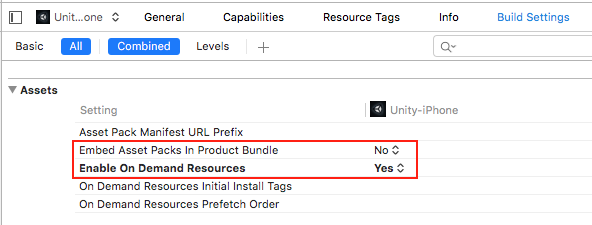
iTunes Connect 处理完应用程序的上传后,单击 TestFlight Builds 中的构建版本即可查看相关的更多信息:

应用程序切片
应用程序切片遵循与按需加载资源类似的流程,允许根据运行应用程序的设备的规格动态下载资源(例如,下载用于 Retina iPad 的高分辨率资源,以及用于 iPhone 和 iPad Mini 等小型设备的低分辨率资源)。这是通过定义 AssetBundles 以及添加__变体__配置来实现的。这样可以在启动时决定使用哪种变体,并在下载时自动将其附加到资源文件名。
要创建变体,请单击新文件夹,然后导航到 Inspector 窗口底部的 Asset Labels 部分。单击右侧下拉菜单,选择 __New__,然后输入新变体的名称。请注意,AssetBundle 变体必须为小写字母。
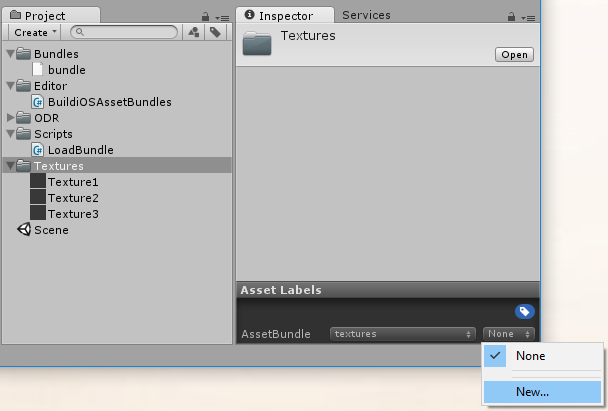
必须在 Editor 脚本中引用新变体。要创建 Editor 脚本,请在 Project 窗口中创建一个名为 Editor 的新文件夹。右键单击 Editor 文件夹,然后选择 Create > C# Script。将新脚本命名为 BuildiOSAppSlices.cs。
复制并粘贴下面的代码,将示例标签(“textures”)和变体(“hd”和“sd”)替换为您自己的标签和变体。在此代码示例中,引用了多个文件夹:一个包含 HD 纹理,一个包含 SD 纹理。它们分别被赋予了变体“hd”和“sd”。
using UnityEngine;
using UnityEditor;
public class BuildiOSAppSlices : MonoBehaviour
{
[InitializeOnLoadMethod]
static void SetupResourcesBuild( )
{
UnityEditor.iOS.BuildPipeline.collectResources += CollectResources;
}
static UnityEditor.iOS.Resource[] CollectResources( )
{
return new UnityEditor.iOS.Resource[]
{
new UnityEditor.iOS.Resource("textures").BindVariant( "Assets/ODR/textures.hd", "hd" )
.BindVariant( "Assets/ODR/textures.sd", "sd" )
.AddOnDemandResourceTags( "textures" ),
};
}
[MenuItem( "Bundle/Build iOS App Slices" )]
static void BuildAssetBundles( )
{
var options = BuildAssetBundleOptions.None;
bool shouldCheckODR = EditorUserBuildSettings.activeBuildTarget == BuildTarget.iOS;
# if UNITY_TVOS
shouldCheckODR |= EditorUserBuildSettings.activeBuildTarget == BuildTarget.tvOS;
# endif
if( shouldCheckODR )
{
# if ENABLE_IOS_ON_DEMAND_RESOURCES
if( PlayerSettings.iOS.useOnDemandResources )
options |= BuildAssetBundleOptions.UncompressedAssetBundle;
# endif
# if ENABLE_IOS_APP_SLICING
options |= BuildAssetBundleOptions.UncompressedAssetBundle;
# endif
}
BuildPipeline.BuildAssetBundles( "Assets/ODR", options, EditorUserBuildSettings.activeBuildTarget );
}
}
这段代码将在 Unity Editor 菜单栏中创建一个名为 Bundle 的新菜单。单击此菜单并选择列表中唯一的菜单项 Build iOS App Slices。此时将在 ODR 文件夹中生成 AssetBundles。
然后,要加载资源,请将此类放在项目中的某个位置,并传入要加载的变体的名称:
using UnityEngine;
using UnityEngine.iOS;
using System;
using System.Collections;
public class LoadBundle : MonoBehaviour
{
public AssetBundle TextureBundle;
void Start( )
{
StartCoroutine( LoadAsset( "textures", "textures" ) );
}
public IEnumerator LoadAsset( string resourceName, string odrTag )
{
// 创建请求
OnDemandResourcesRequest request = OnDemandResources.PreloadAsync( new string[] { odrTag } );
// 等待请求完成
yield return request;
// 检查是否有错误
if( request.error != null )
throw new Exception( "ODR request failed: " + request.error );
TextureBundle = AssetBundle.LoadFromFile( "res://" + resourceName );
request.Dispose( );
}
}
现在可以在 Player Settings > Other Settings > Configuration 中的 Variant map for app slicing 下拉菜单中查看和修改变体(仅当在 Player Settings 中启用了 Use on demand resources 时,此菜单才可见)。
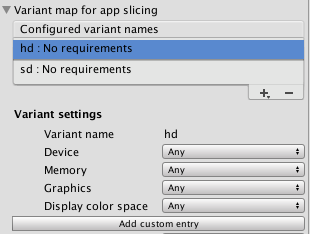
要了解有关 AssetBundles 和按需加载资源的更多信息,请参阅 Bitbucket 上托管的 Unity AssetBundle Manager 演示项目。登陆页面提供了有关如何使用和调整演示项目的全面说明。
- 2018–06–14 页面已修订
Did you find this page useful? Please give it a rating:
Thanks for rating this page!
What kind of problem would you like to report?
Thanks for letting us know! This page has been marked for review based on your feedback.
If you have time, you can provide more information to help us fix the problem faster.
Provide more information
You've told us this page needs code samples. If you'd like to help us further, you could provide a code sample, or tell us about what kind of code sample you'd like to see:
You've told us there are code samples on this page which don't work. If you know how to fix it, or have something better we could use instead, please let us know:
You've told us there is information missing from this page. Please tell us more about what's missing:
You've told us there is incorrect information on this page. If you know what we should change to make it correct, please tell us:
You've told us this page has unclear or confusing information. Please tell us more about what you found unclear or confusing, or let us know how we could make it clearer:
You've told us there is a spelling or grammar error on this page. Please tell us what's wrong:
You've told us this page has a problem. Please tell us more about what's wrong:
Thank you for helping to make the Unity documentation better!
Your feedback has been submitted as a ticket for our documentation team to review.
We are not able to reply to every ticket submitted.